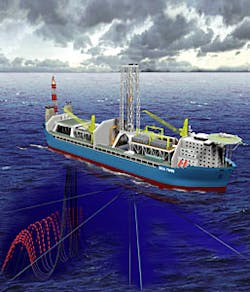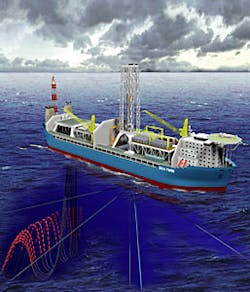Getting around the weathervaning problem
The LMG Marin Sea Twin FDPSO.
Combined floating drilling production storage and offloading (FDPSO) systems based on ships have been occasionally proposed by the offshore industry. FDPSO concepts would offer a variety of advantages, but have, however, so far been unsuccessful in gaining a foothold, partly because of the complexity in combining mooring, drilling, and riser tie-in systems into the same turret.
For a number of reasons, shallow water fixed installations have their own drilling facilities. Successful use of these facilities beyond the original drilling program is ensured by low cost well intervention, improved oil recovery, cheap pocket exploration drilling, extended field life, and others.
Conventional FPSO developments, on the other hand, are fully dependent on external vessel assistance for the same type of work - often this is the same fate of expensive drilling units, if these are available. This has resulted in premature field abandonment and often leaves behind large volumes of undepleted and valuable oil and gas reserves. The addition of drilling facilities to an FPSO will increase the up-front investment in the vessel, but would provide an optimal solution when:
- The operator has a dedicated strategy to maximize recovery in the long run, (with possible pressure/support from authorities)
- Acknowledgement of the fact that the major profits are gained on added reserves after payment of initial investments
- A certain number of wells can be reached within the operating envelope of the moored vessel
- There is a complex reservoir
- Reserve estimates are conservative, with possible and probable upgrading potential
- Plans call for frequent well workovers
- Expectations of new wells or redrilling/ branching
- Low well intervention cost appreciated
- Simplify decision making to re-enter wells (being also cheaper than contracting vessels to work on subsea wells).
In addition, conventional FPSO solutions have so far been dependent on relatively complex and costly turret or swivel solutions to compensate for the required weathervaning of the vessel. A complex mooring/riser tie-in turret may also impose restrictions to number of risers being tied back to the vessel.
LMG Marin, a Norwegian naval architect and marine engineering company, has developed the Sea Twin project, which proposes novel patented solutions for a turret-free FPSO. The main objectives of the Sea Twin development project, as defined by LMG Marin, have been:
- Introduce drilling or well intervention facilities on board a monohull FPSO
- Avoid the use of production turrets and swivels for riser tie-in
- Increase the number of risers
- Maintain safety onboard
- Reduce complexity and cost.
Concept development
LMG Marin says the Sea Twin FPSO (+D option) is a dual bow, monohull ship shaped structure has been under development since 1995. There are currently several patents pending for the project. The vessel features:- Simple and conventional hull design, familiar to most shipyards.
- Concurrent production and drilling/well intervention operations possible.
- Any use of turrets/swivels may be made redundant.
- Tie in of a large number of risers (40+).
- Well suited for operations in very deep waters.
- Fully moored, heading weather in full 360° sector, including hostile environment.
Weathervaning
Avoiding the use of mooring lines, and designing the vessel for dynamic positioning only will solve the FDPSO weathervaning problems, using either one bow or two bows for the vessel. This allows for the avoidance of potential collisions between vertically incoming risers and angled mooring lines.However, offshore production in combination with drilling based on DP rather than permanent mooring is suitable for early production, but hardly acceptable for many years of production on the same location.
As a solution, one company's design utilizes both a mooring system and dynamic positioning system. The firm has to date built a number of MST's (multipurpose shuttle tankers) with two bows, with the objective of heading the weather from both ends. Their solution to the FDPSO challenge has been to moor the vessel conventionally based on the STL/STP turret system, and lock the vessel by the DP system during drilling and workover operations. They have, hence, obtained a substantial segregation between the riser tie-in area and the drilling workover area. The main problem is restriction in vaning during well intervention operations.
The problems related to collisions between risers and mooring lines has also been solved for the Sea Twin FDPSO project. The vessel is capable of covering a full 360° weathervaning sector in combination with 12 mooring lines, plus drilling and full FPSO outfitting. Due to the dual bow design, the vessel will head the weather from both ends, and rotate only +/- 90°. This limited rotation will also make the use of turret mooring redundant.
The distance from the drilling facilities to the riser tie-in area will normally be 40-70 meters. Hence, the best possible safety standards have been maintained on board, and complex integration of drilling, mooring, and riser tie-in systems is avoided.
The main challenge was to design a mooring system that avoided the production risers. A specially designed mooring system has been developed for harsh environment, enabling the FDPSO to operate anywhere in the North Atlantic, while a simpler mooring version is offered for more friendly offshore environments.
40 risers/no turret
In addition to introducing drilling facilities in combination with full mooring assistance on board the Sea Twin FDPSO, a further advance has been made in the riser tie-in area. Analysis performed to date indicates that as many as 40 risers, if so many are needed, may be tied back to the vessel without the use of any turret.Risers may be routed from subsea templates underneath the vessel, which will be accessible by the drilling facilities, in addition to tie-ins from remote satellite completions.
The riser tie-in system will be simple and similar to a semisubmersible FPS. Avoiding the use of any rotating device for the production lines, either turret or swivels, will enhance safety, reduce cost and complexity, and facilitate the tie-in of high pressure wells and gas export lines.
Enhanced safety on board is another feature of the Sea Twin concept, obtained by segregating drilling systems from the production riser tie-in area. Safety is improved by increasing the distance between production and drilling/well intervention activities, and by reducing the complexity of the various systems.
Development to date
LMG Marin says it has developed two versions of the Sea Twin vessel, to date, for use in varying oil storage and processing requirements. The vessel is now commercially available and has been designed in accordance with the relevant DNV codes, and is also offered with full NPD compliance for North Atlantic operations. The Sea Twin vessel can be constructed at a number of qualified yards worldwide and is based on established ship building practice. The absence of a turret will to a large extent finance the introduction of drilling facilities.Copyright 1998 Oil & Gas Journal. All Rights Reserved.




